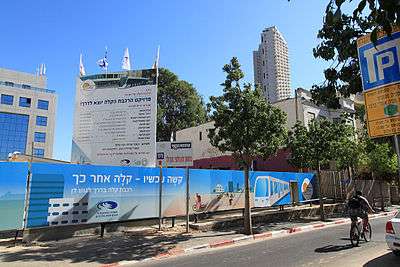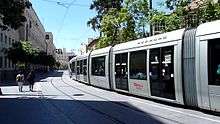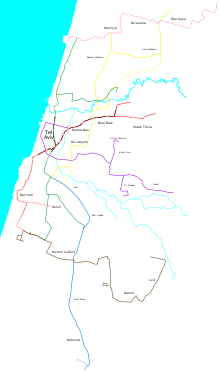Tel Aviv Light Rail

The Tel Aviv Metropolitan Area Mass-Transit System is a planned mass transit system for the Tel Aviv Metropolitan Area. The system will include different types of rapid transit like light rail (which will run underground in some areas), bus and more.
Work on the Red Line, the first in the project, started on September 21, 2011, following years of preparatory works and numerous delays.[1]
History
The first proposals for a tramway in the area were made by the Lebanese engineer George Franjieh in November 1892, about nine weeks after the inauguration of the Jaffa–Jerusalem railway. The plan called for a main line between southern and northeastern Jaffa, with spurs to the harbor and the eastern orchards. The plan was considered uneconomical and was shelved. A later plan called for a light railway from Jaffa to the nearby settlements of Rishon LeZion, Petah Tikva and Wilhelma.[2]
A Decauville light railway was built in Jaffa and Tel Aviv in World War I, connecting the port with the Yarkon River. It was used for about a decade after the war, and dismantled at a later date.
A subway system was first planned in the mid-1960s, and in 1967 a station at the Shalom Meir Tower was inaugurated in the presence of then Prime Minister Levi Eshkol. However, financial difficulties forced the abandonment of the project, and Shalom Meir remains the only subway station in Tel Aviv, disconnected from other transport links.
Revised plan: light rail
In 2000, the plan for a subway was changed to one for light rail, and more plausible plans for a mass transit system in Tel Aviv were unveiled. The first 22 kilometres (14 mi) Red Line has been approved, and excavation began in late 2009, with construction of the underground stations beginning in August 2015. The Red Line is expected to become operational in 2021.
In December 2006, the MTS group was awarded a BOT contract for the Red Line of the light rail, by which they are to build and operate the line for its first 32 years. MTS consists of Africa Israel, Siemens of Germany, the Egged Bus Cooperative, Chinese infrastructure company CCECC, the Portuguese infrastructure firm Soares da Costa, and the leading Dutch transportation company HTM.[3]
After many years of delays due to MTS financing issues, in December 2010 the government revoked MTS' concession and nationalized the project, putting it under the authority of NTA, the government agency which was in charge with overseeing the overall development of the rapid transit system in the Tel Aviv metro area.[4] Alstom, which supplied the trams for the Jerusalem Light Rail, plans to bid to supply trams, as well as signals, and electrical and control systems.[5]
A significant portion of the Tel Aviv Light Rail will be underground, so Tel Aviv may be viewed as the fifth city in the Middle East to boast a subway system. Haifa was first with the Carmelit in 1959, while the Cairo Metro, opened in 1987, the Tehran Metro opened in 1999, the Dubai metro was the fourth when it opened in 2009.
Current status

Up to the year 2010, only the Red Line had been under construction and the construction until then was only infrastructural. The construction has now been finished on some portions of the overground phase of the line and the underground phase got underway in August 2015, including construction of the various underground stations. This required the re-routing of traffic in many locations to enable this work to take place.[6]
The advanced phases of construction are two years late as the owner of the line, MTS, has had financial difficulties and postponed some of the portions. The Israeli government wants to deny the ownership to MTS due to the postponements and construct the line on its own.
The Israeli government plans to construct the Red Line, Green Line and Purple Line simultaneously in order to close the gap created by MTS. Furthermore, Bombardier Transportation has offered to receive the ownership from MTS and offers to use the Flexity 2 rolling stock to the lines. No decision has been made yet.[7][8]
The NTA Metropolitan Mass Transit System Ltd. has published a tender for 90 carriages, with the option of buying 30 more. NTA will begin reviewing bids from companies starting June 2013.[9]
Construction on the first line, from Bat Yam to Petah Tikva, began in August 2015.[10][11]
Planned lines

The blueprint includes eight lines: two in planning stages, one under approval, one under construction, and four more planned for the future. The first four lines will cover 100 km (62 mi) around the Tel Aviv metropolitan area, with future plans to BRT lines and feeders in addition.[12]
| Line | Length | Status | Open Date | Primary Cities |
Terminals | No. Stations |
|---|---|---|---|---|---|---|
| Red Line [13] | 23 km[14] (14 mi) | Under Construction | 2021 est. | Petah Tikva, Bnei Brak, Ramat Gan, Tel Aviv–Jaffa, Bat Yam | Petah Tikva Bus Terminal ● Kiryat Aryeh Depot (Petah Tikva) Nisenboim (Bat Yam) |
33 (10 underground) |
| Green Line[15] | 35 km[14] (15 mi) | Approval | 2024 est. | Herzliya, Tel Aviv, Holon, Rishon LeZion | Herzliya Pituah ● Tel Aviv University Holon Depot ● Moshe Dayan (Rishon LeZion) |
58 (5 underground)[16] |
| Purple Line[17] | 36 km (22 mi) | Early Plans | 2024 est. | Yehud, Or Yehuda, Ramat Gan, Tel Aviv, Kiryat Ono, Giv'at Shmuel, Petah Tikva | Tayasim Junction (Yehud) ● Yahalom Industrial Zone (Or Yehuda) ● Bar Ilan University (Ramat Gan) Arlozorov (Tel Aviv) |
56 |
| Blue Line[18] | 21 km (13 mi) | Early Plans | - | Rehovot, Nes Ziona, Rishon LeZion | Rishon LeZion Center ● Mikve Israel Holon Junction ● Bilu Junction |
40 |
| Yellow Line[19] | 18 km (11 mi) | Early Plans | - | Ra'anana, Kfar Sava, Hod HaSharon, Herzliya, Ramat HaSharon, Ramat Gan, Tel Aviv, Holon | Tshernihovsky (Kfar Sava) ● Raoul Wallenberg (Tel Aviv) Sokolov (Herzliya) ● Hod HaSharon ● Ben-Gurion (Ramat Gan) ● Yitzhak Rabin (Givataim) ● Moshe Dayan (Tel Aviv) ● Mikve Israel |
Unknown |
| Brown Line[20] | 28 km (17 mi) | Early Plans | - | Ramle–Rishon LeZion | Ramle ● Rishon Lezion Center | Unknown |
| Pink Line[21] | Unknown | Early Plans | - | Kfar Sava, Ra'anana, Herzliya | Ra'anana South ● Herzliya | Unknown |
| Orange Line[22] | 16 km (10 mi) | Early Plans | Unknown | |
Unknown | |
Red Line
About 10 kilometres (6 mi) of the 22 kilometres (14 mi) Red Line is to be built underground, with the remaining overground segment constructed in as a light rail/tram. It is to have 33 stops, 10 of which would be underground, with an average distance of 500 metres between them. The average distance between the overground stops would be 1 km. The line would run from Bat Yam in the southwest, through Jaffa and central Tel Aviv, and carry on to Petah Tikva, through Ramat Gan and Bnei Brak. An interchange is planned for Tel Aviv Central railway station. It has been forecast that by 2020, 100 million people would be using this line annually.
Stations (underground in italics): Nissenbaum, HaAmal, Kaf Tet BeNovember, Yoseftal, Bar Ilan, Balfour, Jabotinsky, Rothschild, HaAztmaut, Machrozet, HaBaashat, Issakov, Erlich, Ben Tzvi, Salame, Elifelet, Allenby, Carlebach, Yehudit, Shaul HaMelech, Arlozorov, Abba Hillel, Bialik, Ben-Gurion, Aharonowitz. From Aharonowitz, one branch continues to Shenkar, Rabin, Beilinson, Dankner, Orlov, Pinsker, Petah Tikva Central Bus Station (Terminal); another continues to Em HaMoshavot and the Kiryat Aryeh Maintenance Depot.
The work on Allenby station began on 2.8.2015
Green Line
The second or Green Line, in the approval phase, is a 35 kilometres (22 mi) line with 58 stops that would run from the west of Rishon LeZion northwards through Holon through central Tel Aviv and will split into two branches: One to Herzliya in the north, and one to Ramat HaHayal neighborhood in Tel Aviv in the northeast. Only its central Tel Aviv segment would be underground, from Levinski Street through Ibn Gabirol Street until the Yarkon River. Four of the fifty-eight stations will be underground. The expected annual passenger forecast is 65 million. NTA is including the design and boring of the Green Line's tunnels as part of Red Line's tunnels overall contract so that work on the Green Line's underground portion can commence immediately following the completion of the Red Line tunnels.
Purple Line
The third, or Purple Line, also in the planning phase, is envisaged as a 36 kilometres (22 mi) line with 56 stops and will connect Petah Tikva Sgula to Sheba Hospital through Giv'at Shmuel and Kiryat Ono, and will connect Arlozorov in Tel Aviv to Yehud and Or Yehuda through Ramat Gan. There are considerations to make the central part of the line (From Sheba Hospital to Arlozorov) underground.
Yellow Line
This line is being planned. It will begin in Kfar Saba then continue on to Hod Hasharon, Herzliya, Ramat Hasharon on Sokolov Street, before joining Ben-Gurion Street in Ramat Gan, then Yitzhak Rabin Street in Givataim, then Moshe Dayan Street in Tel Aviv, Mikveh Israel, it will end in Holon after crossing Ariel Sharon Park. This line was designed initially as a bus rapid transit, however, currently the possibility of making it a light rail line is being considered.
Blue Line
The fifth, or Blue Line, is the first line of the BRT system and the first line not to pass via Tel Aviv. The line will begin in Rehovot and continue to HaRishonim Railway Station in Rishon LeZion via Ness Ziona and end at the Holon junction.
Brown Line
The sixth, or Brown Line, is a planned BRT line that will serve the southern metropolitan area, beginning in Moshe Dayan Railway Station at western Rishon LeZion in a connection with the Red Line and the Green Line, continues east via central Rishon Lezion, Bypasses Assaf HaRofeh Medical Center, and continues to Ramle where it splits into two branches: One continues to Lod in the northeast, and the second continues to eastern Ramle in the east. There is a possibility of making it a light rail line eventually.
Pink Line
The seventh, or Pink Line, is a planned BRT line that will serve the northern metropolitan area, beginning in northeastern Kfar Saba and continues through its main streets until, crossing Highway 4 to Ra'anana and continues through Ahuza Street until western Ra'anana and continues to Herzliya and crosses it until the Marina area, where it terminates. There is an alternative service of the line through Highway 4 and Highway 2 to Tel Aviv, that splits from the main service in the Kfar Saba-Ra'anana border.
Orange Line
The eighth and last to date, or Orange Line, is a planned BRT line that will be the only line which is isolated from the system. It will serve only the city of Netanya in the northern metropolitan area. It will be a circular line that connects both sides of the city, crossing Highway 2. Actual route of the line is still unknown. The line will be connected to the system only by other transport means, such as Israel Railways and buses.
See also
References
- ↑ Amiram Barkat (September 20, 2011). "Work begins on Tel Aviv light rail". Globes. Retrieved April 15, 2012.
- ↑ Cotterell, Paul. "A Tramway Project in Jaffa". HaRakevet (6): 11–12.
- ↑ "6: Light Rapid Transit". HaRakevet (80): 4. March 2008. ISSN 0964-8763.
- ↑ http://www.nrg.co.il/online/16/ART2/188/317.html The government officially nationalizes the construction of the Tel Aviv red line (Hebrew)
- ↑ http://www.globes.co.il/serveen/globes/docview.asp?did=1000789231&fid=1724
- ↑ http://www.globes.co.il/en/article-work-begins-on-ramat-gans-bialik-light-rail-station-1001082538
- ↑ עופר פטרסבורג (2 June 2010). חברה קנדית מציעה להקים רכבת קלה בת"א [Canadian company offers to build Tel Aviv light rail] (in Hebrew). ynet. Retrieved April 15, 2012.
- ↑ ליאור גוטמן, "כלכליסט" (June 17, 2010). זכיינית הרכבת בת"א קיבלה 7 ימים למצוא מימון [Tel Aviv train franchise has seven days to find financing] (in Hebrew). ynet. Retrieved April 15, 2012.
- ↑ http://www.globes.co.il/serveen/globes/docview.asp?did=1000797046&fid=1725
- ↑ http://www.ynetnews.com/articles/0,7340,L-4648378,00.html
- ↑ http://www.haaretz.com/israel-news/.premium-1.669048
- ↑ Description on each line in the system (Hebrew)
- ↑ The Red Line (Hebrew)
- 1 2 Thomas, Tris (January 16, 2012). "Pre-Qualification call for Tel-Aviv Metro works". Tunnelling Journal. Retrieved February 29, 2012.
- ↑ The Green Line (Hebrew)
- ↑ Maor, Tami (December 24, 2012). "Test Drilling for Green Line of Tel Aviv Light Rail". Tel Aviv Local (in Hebrew). Retrieved December 25, 2012.
- ↑ The Purple Line (Hebrew)
- ↑ The Blue Line (Hebrew)
- ↑ The Yellow Line (Hebrew)
- ↑ The Brown Line (Hebrew)
- ↑ The Pink Line (Hebrew)
- ↑ The Orange Line (Hebrew)
External links
| Wikimedia Commons has media related to Tel Aviv Light Rail. |
- June 2010 update to the map of National Outline Plan 23 regarding the light rail at the Israel Land Administration
- NTA (in English) – Tel Aviv Subway developer, builder and operator.
- NTA (in Hebrew)
- Map of all lines on Govmap.gov.il